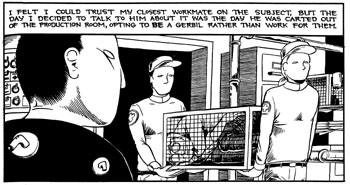Inner Cubicles Of Hell
Two cartoonists dissect workers' anomie in the modern market
By Richard von Busack
TWO LOCAL cartoonists have been escaping from escapism by creating exemplary work themed on the workplace: Clay Butler, in political cartoons outlining the surrender of spine, brain and soul at the job; and Jeff Nicholson, in a scarifying self-portrait of the artist as a zombie enslaved by his workplace.
Sidewalk Bubblegum (which appears weekly in Metro's sister publication Metro Santa Cruz) has been collected in The Glory of Capitalism (Scare Me Press; $12). Butler is probably the best draftsman to do political panel cartoons since Ron Cobb back in the 1960s. He possesses a special gift for drawing different species of late-20th-century types: anonymous midlevel managers, wife-beating rageballs and TV news anchormen.
The Glory of Capitalism targets not just supply-side economists but also sunny-side journalists. A prime Butler gag depicts a newsman reassuring a homeless woman that at least her children don't have to worry about exposure to Internet pornography.
Butler excels at drawing out the monstrosity of societally endorsed heroes. In one cartoon, we see Butler's vision of that urban legend "the self-made man" as a Frankenstein's monster built out of other people's flesh. In another, he shows how the insistence on "eye for an eye, tooth for a tooth" leaves us all blind and toothless, as Martin Luther King Jr. once put it.
Though Butler's monsters are no slouches themselves, monstrosity grows more frightening the more human it gets. The genuinely harrowing graphic novel Through the Habitrails ($14.95), published by Petaluma's Bad Habit comics, is dubbed "semi-autobiographical" in the introduction by Stephen R. Bissette. I hope there's a heavy accent on the words "semi."
Through the Habitrails represents very serious work indeed from a cartoonist known from his lightweight funnies in Father and Son and Ultra Klutz. You'd never recognize the author of those entertainments in this story of frustration, desensitization and incipient madness in the workplace.
Nicholson's graphic novel consists of a cycle of illustrated stories linked by the protagonist, who holds down a grim job as a commercial artist--he sketches cute little advertising figures for a small company. As a gesture of compassion--or maybe condescension--the employers provide little pet gerbils that have the run of the office in plastic tunnels. The rodents are "empaths of stress and despair," Nicholson explains, that act out the misery of the employees, who sometimes kill them when the pressure becomes unbearable.
Other aspects of the office, full of dislocation as it is, include a mean and unattractive lifer whom the protagonist calls the "Doomed One," and an infiltrator who has been collecting records on all of the employees, even photographing their lunches for further study.
NICHOLSON'S Habitrail Man flashes clear early-warning signs of going nuts. He wantonly kills animals, and receives regular visitations from an imaginary crowned "Gerbil King" that follows him, giving him orders.
This nightmare tale is illuminated with flashes of sanity, represented by three stories called "Escapes." All three represent hopeless trips to the country. Escape No. 1 is a walk along an abandoned roadway, bypassed, going to seed and marked by "a solitary highway reflector standing in a field of dead grass."
There's a Poe-like passage in the second escape in which Habitrail Man takes a long hike out of the rubble of the city, arriving at a tunnel at the mouth of which he spies his double emerging.
The third escape, perhaps the most disturbing, details a road trip out to the countryside where the hero used to vacation. Now, years later, the woods team with survivalists, refugees and dead animals.
Through the Habitrails casts a far too chilling spell to be dismissed as the self-pity, however understandable, of an artist deathly ill of whoring himself. So I recommend it with much warning to readers repelled by gorier fantasies; strange, isn't it, how the killing of pets, even in cartoon form, disturbs more than the killing of people.
But what Nicholson's cartooning lacks in compassion it makes up for in mood and force. Though it's sometimes meant to be funny, Nicholson's reptilian indifference, as he watches his mouthless characters work without protest, proves too fearful for mere laughter.
[ Metro | Metroactive Central | Archives ]
This page was designed and created by the Boulevards team.

Media Junkie: Jeff Nicholson's hapless wage slave mainlines all the pop-cultural drugs he can lay his tubes on in "Through the Habitrails."  Wage Slaves
Wage Slaves
From the November 7-13, 1996 issue of Metro
Copyright © 1996 Metro Publishing, Inc.
![[Metroactive Books]](/books/gifs/books468.gif)